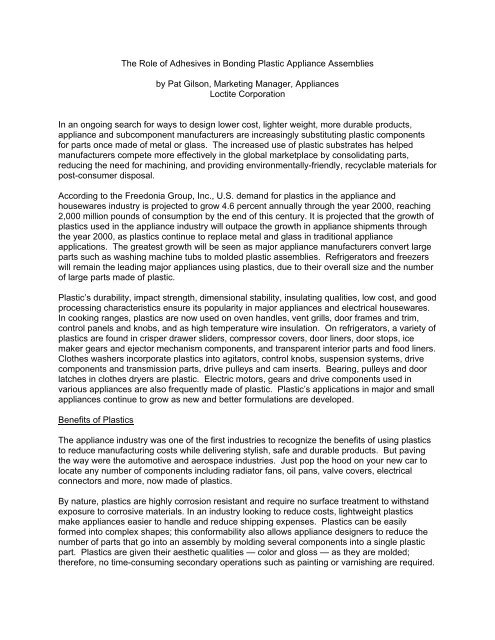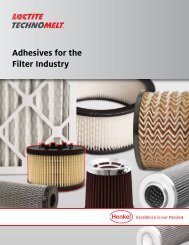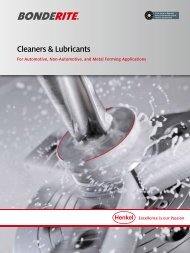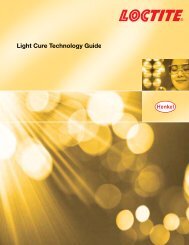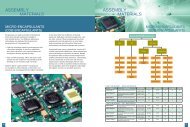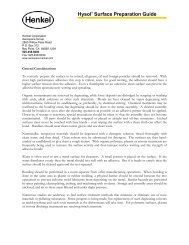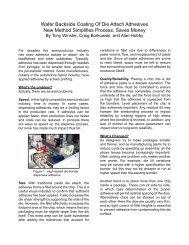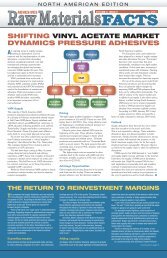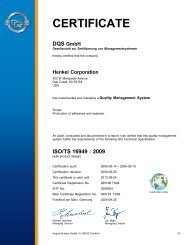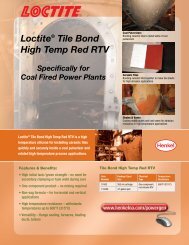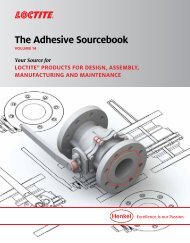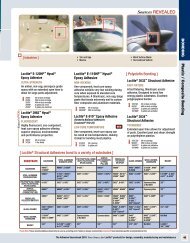Assembly of Plastic Adhesive Components
Assembly of Plastic Adhesive Components
Assembly of Plastic Adhesive Components
You also want an ePaper? Increase the reach of your titles
YUMPU automatically turns print PDFs into web optimized ePapers that Google loves.
The Role <strong>of</strong> <strong>Adhesive</strong>s in Bonding <strong>Plastic</strong> Appliance Assemblies<br />
by Pat Gilson, Marketing Manager, Appliances<br />
Loctite Corporation<br />
In an ongoing search for ways to design lower cost, lighter weight, more durable products,<br />
appliance and subcomponent manufacturers are increasingly substituting plastic components<br />
for parts once made <strong>of</strong> metal or glass. The increased use <strong>of</strong> plastic substrates has helped<br />
manufacturers compete more effectively in the global marketplace by consolidating parts,<br />
reducing the need for machining, and providing environmentally-friendly, recyclable materials for<br />
post-consumer disposal.<br />
According to the Freedonia Group, Inc., U.S. demand for plastics in the appliance and<br />
housewares industry is projected to grow 4.6 percent annually through the year 2000, reaching<br />
2,000 million pounds <strong>of</strong> consumption by the end <strong>of</strong> this century. It is projected that the growth <strong>of</strong><br />
plastics used in the appliance industry will outpace the growth in appliance shipments through<br />
the year 2000, as plastics continue to replace metal and glass in traditional appliance<br />
applications. The greatest growth will be seen as major appliance manufacturers convert large<br />
parts such as washing machine tubs to molded plastic assemblies. Refrigerators and freezers<br />
will remain the leading major appliances using plastics, due to their overall size and the number<br />
<strong>of</strong> large parts made <strong>of</strong> plastic.<br />
<strong>Plastic</strong>’s durability, impact strength, dimensional stability, insulating qualities, low cost, and good<br />
processing characteristics ensure its popularity in major appliances and electrical housewares.<br />
In cooking ranges, plastics are now used on oven handles, vent grills, door frames and trim,<br />
control panels and knobs, and as high temperature wire insulation. On refrigerators, a variety <strong>of</strong><br />
plastics are found in crisper drawer sliders, compressor covers, door liners, door stops, ice<br />
maker gears and ejector mechanism components, and transparent interior parts and food liners.<br />
Clothes washers incorporate plastics into agitators, control knobs, suspension systems, drive<br />
components and transmission parts, drive pulleys and cam inserts. Bearing, pulleys and door<br />
latches in clothes dryers are plastic. Electric motors, gears and drive components used in<br />
various appliances are also frequently made <strong>of</strong> plastic. <strong>Plastic</strong>’s applications in major and small<br />
appliances continue to grow as new and better formulations are developed.<br />
Benefits <strong>of</strong> <strong>Plastic</strong>s<br />
The appliance industry was one <strong>of</strong> the first industries to recognize the benefits <strong>of</strong> using plastics<br />
to reduce manufacturing costs while delivering stylish, safe and durable products. But paving<br />
the way were the automotive and aerospace industries. Just pop the hood on your new car to<br />
locate any number <strong>of</strong> components including radiator fans, oil pans, valve covers, electrical<br />
connectors and more, now made <strong>of</strong> plastics.<br />
By nature, plastics are highly corrosion resistant and require no surface treatment to withstand<br />
exposure to corrosive materials. In an industry looking to reduce costs, lightweight plastics<br />
make appliances easier to handle and reduce shipping expenses. <strong>Plastic</strong>s can be easily<br />
formed into complex shapes; this conformability also allows appliance designers to reduce the<br />
number <strong>of</strong> parts that go into an assembly by molding several components into a single plastic<br />
part. <strong>Plastic</strong>s are given their aesthetic qualities — color and gloss — as they are molded;<br />
therefore, no time-consuming secondary operations such as painting or varnishing are required.
Finally, plastics can be tailored with great precision to meet the specific needs <strong>of</strong> appliance<br />
manufacturers. Virtually limitless combinations <strong>of</strong> plastic types, fillers, and additives are<br />
available which can be compounded at relatively low costs and processed by a variety <strong>of</strong><br />
methods. By properly selecting plastic types/blends, additives and fillers, the physical, chemical<br />
and thermal properties <strong>of</strong> the plastic can be made to meet or exceed the performance<br />
requirements <strong>of</strong> almost any application.<br />
Assembling Appliances With <strong>Plastic</strong> Parts<br />
For appliance manufacturers that require a method <strong>of</strong> assembly that is suitable for automation<br />
and results in a durable, aesthetically pleasing end-product, fastening with adhesives <strong>of</strong>fers the<br />
most versatility.<br />
Whether bonding plastic to plastic or plastic to another material, adhesives <strong>of</strong>fer several major<br />
benefits. Whereas mechanical fastening methods concentrate the stress in one spot, with<br />
adhesives, the load is spread over a wide area, reducing the amount <strong>of</strong> stress on the joint. As<br />
adhesives are applied inside the joint itself, they become an invisible component in the<br />
assembly. Mechanical fasteners such as rivets, nuts, and bolts require holes to be drilled into<br />
the assembly, and frequently interfere with the aesthetic styling <strong>of</strong> the product. Neither<br />
ultrasonic nor solvent welding can bond plastic to metals or glass — only adhesives can provide<br />
such a bond. Also, adhesives are a lower cost fastening method — mechanical fasteners must<br />
be inventoried, require pre-assembly preparation, and are labor intensive. <strong>Adhesive</strong>s are onesize-fits-all,<br />
and assembly can be easily automated.<br />
While the limitless variety <strong>of</strong> plastics is an invaluable asset to an appliance designer, it is also<br />
the biggest limitation when selecting an adhesive to bond a plastic assembly together. The<br />
countless adhesives available, coupled with the virtually limitless grades <strong>of</strong> plastic, make it<br />
difficult to determine the bond strength data for the adhesive/plastic combination designed into a<br />
specific appliance. However, by analyzing the fillers and additives that have been formulated<br />
into the plastic, the adhesive manufacturer can help to pinpoint the adhesive with the best bond<br />
strength for a specific application. To keep abreast <strong>of</strong> the latest developments in plastic<br />
materials, certain adhesive formulators have formed alliances with major plastics manufacturers<br />
to ensure the compatibility <strong>of</strong> their adhesive products, as well as the continued development <strong>of</strong><br />
new adhesives for the future.<br />
An adhesive cannot be selected for an application solely on the basis <strong>of</strong> bond strength. Other<br />
important factors play a critical role in determining the best adhesive for an application. These<br />
factors include cure speed, environmental and thermal resistance, and manual versus<br />
automated application methods.<br />
The newest and fastest growing adhesive technology for plastic bonding applications are new<br />
categories <strong>of</strong> ultraviolet (UV) and visible light curing adhesives. Light curing adhesives were first<br />
introduced approximately 30 years ago and are ideally suited for in-line, automated dispensing<br />
and curing. These adhesives cure or harden when exposed to light sources <strong>of</strong> the appropriate<br />
wavelength and intensity. The primary advantage <strong>of</strong> light cure processing is cure speed.<br />
Depending upon the product and system, cures can be achieved within seconds. Light cure<br />
adhesives are one-part systems with no need to measure or mix, and no pot life concerns.<br />
They contain no solvents and, therefore, are environmentally friendly. Light cure adhesives<br />
<strong>of</strong>fer a very rapid (2 to 60 second) room temperature cure and require substantially less<br />
equipment space and energy than ovens. These adhesives cure “on command,” allowing the<br />
manufacturer as much time as necessary to align parts. Once cured, bonded parts may be
tested immediately after assembly, eliminating the possibility <strong>of</strong> large quantities <strong>of</strong> work-inprocess<br />
scrap.<br />
In order for light cure adhesives to function, the uncured adhesive must “see” or be exposed to<br />
the suitable type and intensity <strong>of</strong> light. This means that at least one <strong>of</strong> the substrates being<br />
bonded must be capable <strong>of</strong> transmitting light. Assemblies with shaded areas require a<br />
secondary cure mechanism for the adhesive to completely solidify.<br />
Three light cure adhesive technologies are popular among today’s appliance manufacturers.<br />
Light cure acrylics are one-part, solvent free liquids with typical cure times <strong>of</strong> 2 to 60 seconds<br />
and cure depths in excess <strong>of</strong> .5 inch. Available in a wide range <strong>of</strong> formulations which provide<br />
cured properties from very rigid, glassy materials to s<strong>of</strong>t, flexible elastomers, light curing acrylics<br />
provide good environmental resistance, superior gap filling properties, and clear bond lines for<br />
improved end use aesthetics.<br />
UV light cure silicones are one-part, solvent-free materials which rely on UV light as the primary<br />
curing mechanism, and moisture for secondary curing in shadowed areas unexposed to the light<br />
source. Used in the appliance industry primarily as sealants and gasketing materials, UV curing<br />
silicones are designed to cure tack-free in less than one minute when exposed to a suitable light<br />
source. The relatively new technology is ideal for high volume production environments, as UV<br />
cure silicones can easily replace traditional room temperature vulcanizing (RTV) silicones which<br />
require one hour to achieve handling strength and up to 72 hours to cure fully. UV cure<br />
silicones speed production time and reduce work-in-progress and production costs, yet <strong>of</strong>fer all<br />
the benefits <strong>of</strong> RTV silicones — thermal resistance to 400°F, excellent moisture and electrical<br />
resistance, and superior gap filling capabilities.<br />
Light cure cyanoacrylates (CA’s) are the newest adhesive technology on the market today.<br />
Light cure cyanoacrylates <strong>of</strong>fer all the performance benefits <strong>of</strong> regular instant adhesives —<br />
rapid room temperature cure, excellent adhesion to most substrates, easy dispense via<br />
automation, and excellent bond strength —along with the added benefit <strong>of</strong> instant, tack-free<br />
cures when exposed to UV or visible light. Light cure CA’s solve two problems associated with<br />
standard cyanoacrylates — they do not require the use <strong>of</strong> solvent-borne accelerators to speed<br />
the cure process, and they minimize or completely eliminate problems with blooming. Any<br />
shadowed areas not exposed to light will continue to cure using the CA’s normal moisture cure<br />
properties.<br />
DVD’s — How Light Cure <strong>Adhesive</strong>s Made A New Technology Possible (sidebar)<br />
Digital Versatile Discs (DVD’S) are the next generation media format for the audio, video,<br />
computer, and multimedia industries. Although similar in many ways to CD’s, DVD’s <strong>of</strong>fer<br />
greatly increased storage capacity and are more user-friendly. As an example <strong>of</strong> storage<br />
capacity, a video made for a DVD player will not only store an entire movie, but will <strong>of</strong>fer viewers<br />
choices on camera angles and sound track languages as well.<br />
There are several generations <strong>of</strong> DVD’s. They include the DVD-5 which <strong>of</strong>fers 4.7 GB storage<br />
capacity with a read only capability from one side; the DVD-10 which <strong>of</strong>fers a 9.4 GB storage<br />
capacity with a read only capability from both sides <strong>of</strong> the disc (the disc must be turned over or<br />
played in special equipment with two heads). The third generation DVD, the DVD-9, has a 8.5<br />
GB capacity and requires a new generation DVD player with the ability to read both sides <strong>of</strong> the<br />
disc from one head.
The new DVD formats with increased data densities present some challenges for assembly and<br />
in-line inspection. As with CD’s, warpage or disc tilt tolerance is critical to the playing<br />
performance <strong>of</strong> the disc.<br />
A DVD is comprised <strong>of</strong> two 0.6 mm polycarbonate discs with the same diameter as the single<br />
1.2 mm CD. The basic manufacturing process for DVD’s is very similar to that <strong>of</strong> CD’s except<br />
that additional equipment and tighter process controls are necessary to minimize tilt.<br />
Polycarbonate material is injection molded into a master disc. After injection molding, a layer <strong>of</strong><br />
aluminum is vacuum deposited onto the information encoded side <strong>of</strong> the disc, and the disc is<br />
then coated with a UV protective lacquer and cured. The .6 mm disc is then ready for bonding.<br />
Some DVD manufacturers have eliminated the lacquer coating step and instead have the<br />
adhesive double as a protective coating.<br />
The adhesive technology used for DVD bonding must be compatible with the substrate<br />
components, and be easily optimized and integrated into replication lines. The adhesive must<br />
also meet cycle time requirements, allow for easy handling and dispensing, maintain adequate<br />
environmental conditioning resistance, and produce minimal degradation <strong>of</strong> the performance <strong>of</strong><br />
the disc.<br />
<strong>Adhesive</strong>s currently used to bond DVD’s include UV curing acrylics, cationic UV epoxies, and<br />
hot melts. Hot melts can be used effectively only on DVD-5 single layer formats; cationic UV<br />
epoxies are effective on both DVD-5 single layer and DVD-10 double sided discs but require a<br />
UV lacquer protective coating prior to bonding. Free radical UV acrylics are the only adhesives<br />
currently on the market that can be tailored to meet the refractive index requirements necessary<br />
to allow the DVD reader to access information on all four layers <strong>of</strong> a double sided DVD-9 disc.<br />
Free radical UV acrylic adhesives are only available from Loctite, and can be applied via spin<br />
coating or capillary flow methods.<br />
Spin coating is the application method most common in the industry. The adhesive is applied to<br />
one disc half, the mating disc is then placed on top <strong>of</strong> the adhesive, and the assembly is spun at<br />
a high rpm to distribute an even film throughout the 120 mm disc. Once adhesive coating is<br />
completed, the mated discs are irradiated under UV light on an in-line conveyor system or rotary<br />
index table. The discs are then inspected to detect any defects that occurred during the<br />
assembly process.<br />
UV Cured-In-Place Compression Gaskets Increase Production, Reduce <strong>Assembly</strong> Costs<br />
(sidebar)<br />
Secoh Sangyo Co. Ltd., a leading manufacturer <strong>of</strong> pneumatic blowers, uses Loctite ® Fast<br />
Gasket cured-in-place compression gaskets to significantly reduce their material and labor<br />
costs and to increase overall productivity on their line <strong>of</strong> diaphragm blowers. The blowers pump<br />
and filter ambient air, and are an integral component in jacuzzi manufacturing.<br />
Before using Fast Gasket, polypropylene blower units were assembled manually by three<br />
workers. Two o-rings made <strong>of</strong> pre-cut EPDM were used for each unit: one on the housing case<br />
and the other on the inside chamber flange. The company had to maintain an in-house<br />
inventory <strong>of</strong> each gasket, which was made by a contracted vendor from a mold die.<br />
In deciding whether to use a liquid gasketing material, Secoh Sangyo had three requirements:<br />
1) it must seal the outer case to protect the blower from rain and dust; 2) it must maintain a tight
seal, keeping the inside pressure at 0.2 kg/cm 2 , and 3) it must stick bond-free, since opening<br />
the hood is required for maintenance.<br />
Fast Gasket compression gaskets are durable silicone gasketing materials that are dispensed<br />
and then cured under UV light in less than 30 seconds. They eliminate the need for inventories<br />
<strong>of</strong> different sized gaskets, speed assembly, and reduce placement error.<br />
Secoh Sangyo now uses an in-house, automated application process. Fast Gasket is<br />
dispensed with a robotically-operated pneumatic pump directly to the chamber flange and the<br />
housing case. Each blower travels via conveyor through a UV curing furnace for 30 seconds.<br />
The case hood is then manually assembled.<br />
Secoh Sangyo has realized the following benefits from their assembly process change:<br />
1) reduced gasketing material costs by 11.5 percent;<br />
2) dramatically reduced labor costs from three workers to one for the gasketing process;<br />
3) increased productivity by 10 percent by cutting application time by 3 minutes; and<br />
4) eliminated cut gasket inventory costs.


